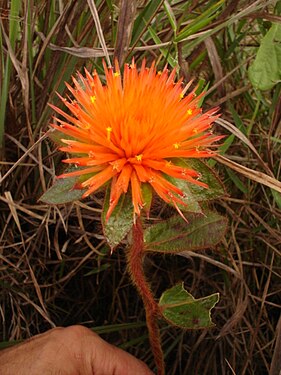Gomphrena
| Habit | shrub |
|---|
If this plant info box on watering; zones; height; etc. is mostly empty you can click on the edit tab and fill in the blanks!
Gomphrena[1][2] (pronounced /ɡɒmˈfriːnə/)[3] the Globe amaranths, is a genus of plants in the family Amaranthaceae.
Read about Gomphrena in the Standard Cyclopedia of Horticulture
|
|---|
|
Gomphrena (name suggested by Gomphraena, Pliny's name for some amaranth, supposed to be derived from grapho. to write or paint; alluding to the highly colored or ' painted" foliage). Amarantaceae. Herbaceous plants grown as "everlastings." Herbs erect or prostrate, pubescent to villous, with or without a leafy involucre: fls. short or long, white or colored: bracts short or long, concave, and keeled, winged or crested on the back.—About 70 species, mostly in the warmer parts of Amer. and Austral., but the globe amaranth is widely dispersed throughout the tropics. For cult., see Annuals and Everlastings. This genus includes the globe amaranth, a common everlasting flower of easy culture. It is also known as bachelor's button, though two other utterly distinct plants (Centaurea cyanus and Ranunculus acris) have the same popular name. The flower-heads are an inch or less in diameter, globose, of many colors, and chiefly remarkable for the showy bracts, which hide the true flowers. In a family remarkable for brilliant foliage this genus seems to be the only one valued for everlastings. Nearly all the other everlasting flowers of importance belong to the Composite. G. gnaphalioides, Vahl (syn. Pfaffia).
|
Cultivation
Propagation
Pests and diseases
Species
Species include:
- Gomphrena globosa - Globe amaranth
- Gomphrena haageana - Strawberry globe amaranth
- Gomphrena perennis - Glyphosate resistant
- Gomphrena serrata
Gallery
References
- ↑ Template:ITIS
- ↑ Gomphrena at USDA PLANTS Database
- ↑ Sunset Western Garden Book, 1995:606–607
External links
- w:Gomphrena. Some of the material on this page may be from Wikipedia, under the Creative Commons license.
- Gomphrena QR Code (Size 50, 100, 200, 500)



